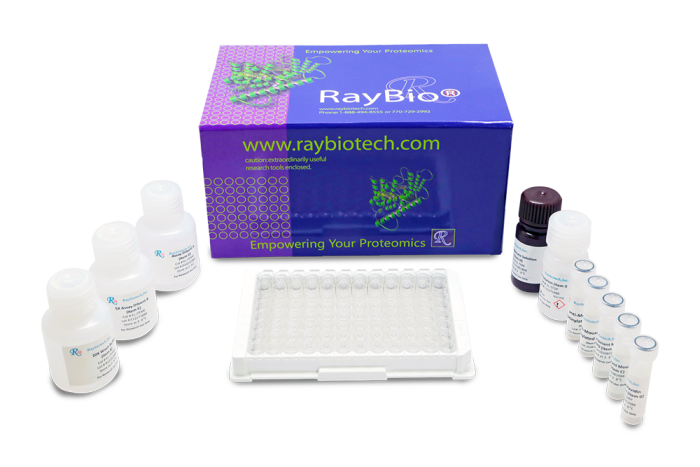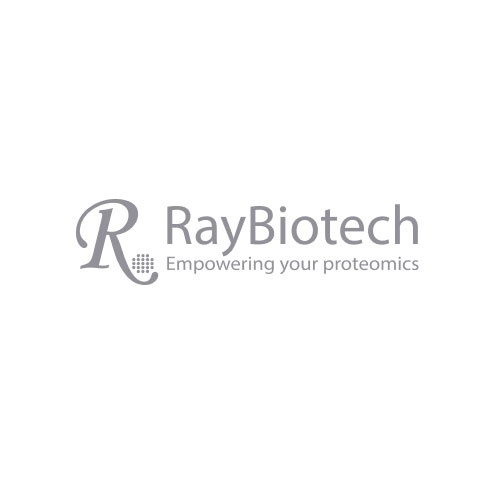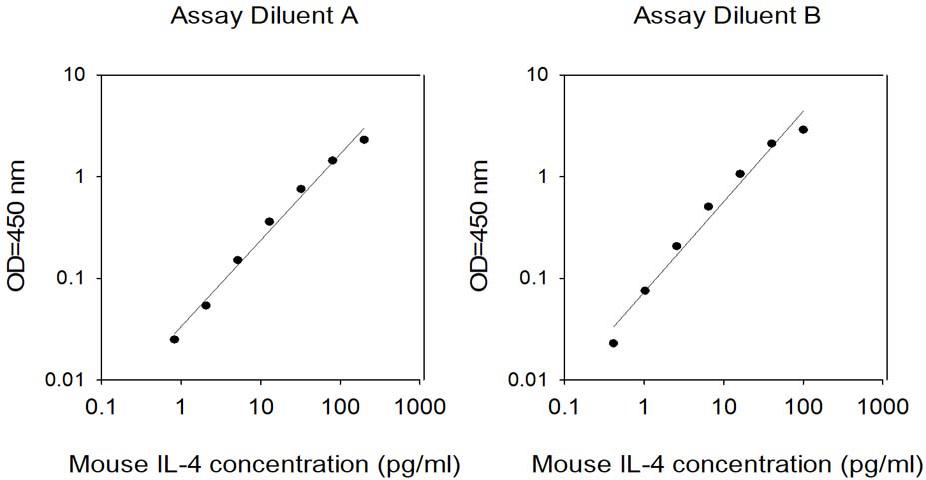Mouse IL-4 ELISA Kit
RayBio® Mouse IL-4 ELISA Kit for cell culture supernatants, plasma, serum, and lysate samples.
Lead time: Typically ships within 1-2 business days. No Friday shipments.
Product Description
Specifications
| Size | 1 Plate Kit, 2 Plate Kit, 5 Plate Kit |
|---|---|
| Species | Mouse |
| Accession Number | P07750 |
| Gene Id | 16189 |
| Gene Symbols | IL4|IL-4 |
| Protein Name / Synonyms | Interleukin-4 (IL-4) (B-cell IgG differentiation factor) (B-cell growth factor 1) (B-cell stimulatory factor 1) (BSF-1) (IGG1 induction factor) (Lymphocyte stimulatory factor 1) |
| Quantitative/Semi-Quantitative | Quantitative |
| Specificity | This ELISA kit shows no cross-reactivity with any of the cytokines tested: Mouse CD30, L CD30, T CD40, CRG-2, CTACK, Eotaxin , Eotaxin-2, Fas Ligand, Fractalkine, GCSF, GM-CFS, IFN- gamma, IGFBP-3, IGFBP-5, IGFBP-6, IL-1 alpha, IL-1 beta, IL-2, IL-3, IL-3 Rb, IL-5, IL-6, IL-9, IL-10, IL-12 p40/p70, IL-12 p70, IL-13, IL-17, KC, Leptin R, LEPTIN(OB), LIX, L-Selectin, Lymphotactin, MCP-1, MCP-5, M-CSF, MIG, MIP-1 alpha, MIP-1 gamma, MIP-2, MIP-3 beta, MIP-3 alpha, PF-4, P-Selectin, RANTES, SCF, SDF-1 alpha, TARC, TCA-3, TECK, TIMP-1, TNF-alpha, TNF RI, TNF RII, TPO, VCAM-1, VEGF. |
| Compatible Sample Types | Cell Culture Supernatants, Plasma, Serum, Tissue Lysates, Cell Lysates |
| Solid Support | 96-well Microplate |
| Method Of Detection | Colorimetric |
| Design Principle | Sandwich-based |
| Sensitivity | 0.6 pg/ml Need more sensitivity? Check out the new BIQ-ELISA™ kit for this target. Still not enough? Then your answer is our Ultrasensitive Biomarker Testing Service powered by Simoa™ technology. |
| Detection Range | 0.6 pg/ml - 200 pg/ml |
| Recommended Dilution (Serum/Plasma) | 2 fold |
| Estimated Lead Time | 1-2 business days |
| Shipping Type | Blue ice |
| Storage | ≤-20°C |
Risk-Free Guarantee
We offer a 100% guarantee on all ELISA kits and membrane cytokine arrays.
Learn More
Amazon Gift Cards!
$5 Amazon gift card in every kit box purchased.
Fang Y., Yao L., Li C., et al. The blockage of the Nogo/NgR signal pathway in microglia alleviates the formation of A? plaques and tau phosphorylation in APP/PS1 transgenic mice. J Neuroinflammation. 2016; 13: 56. Published online 2016 Mar 3. doi: 10.1186/s12974-016-0522-x
Rodrigues MA., Figueiredo L., Padrela L., et al. Development of a novel mucosal vaccine against strangles by supercritical enhanced atomization spray-drying of Streptococcus equi extracts and evaluation in a mouse model. Eur J Pharm Biopharm. 2012 Oct;82(2):392-400. doi: 10.1016/j.ejpb.2012.07.005.
Xiao G, Li X, Kumar A, Cui Z. Transcutaneous DNA immunization following waxing-based hair depilation elicits both humoral and cellular immune responses. European journal of pharmaceutics and biopharmaceutics?: official journal of Arbeitsgemeinschaft fur Pharmazeutische Verfahrenstechnik eV. 2012;82(1):212-217. doi:10.1016/j.ejpb.2012.06.012.
Jian Y., Zou Y., Chen S., Zhu C., Wu A., Liu Y., Ma L., et al. The anti-inflammatory effect of donepezil on experimental autoimmune encephalomyelitis in C57 BL/6 mice. Neuropharmacology 73 (2013) 415-424
Liu J., et al. Sub-10 nm Monoclinic Gd2O3:Eu3+ Nanoparticles as Dual-Modal Nanoprobes for Magnetic Resonance and Fluorescence Imaging. Langmuir, Article ASAP, 2014. DOI: 10.1021/la503228v
Tian X., et al. Toxicity evaluation of Gd2O3@SiO2 nanoparticles prepared by laser ablation in liquid as MRI contrast agents in vivo. International Journal of Nanomedicine. 2014 Aug 21;9:4043-53. doi: 10.2147/IJN.S66164.
Dey P., Ray S., Chaudhuri T. Immunomodulatory activities and phytochemical characterisation of the methanolic extract of Dioscorea alata aerial tuber. Journal of Functional Foods . Volume 23, May 2016, Pages 315-328. https://doi.org/10.1016/j.jff.2016.02.044
Ghosh S., Mukherjee S., Choudhury S., et al. Reactive oxygen species in the tumor niche triggers altered activation of macrophages and immunosuppression: Role of fluoxetine. Cell Signal. 2015 Jul;27(7):1398-412. doi: 10.1016/j.cellsig.2015.03.013.
Ghosh S., Mukherjee S., Choudhury S., et al. Reactive oxygen species in the tumor niche triggers altered activation of macrophages and immunosuppression: Role of fluoxetine. Cell Signal. 2015 Jul;27(7):1398-412. doi: 10.1016/j.cellsig.2015.03.013.
Ghosh S., Mukherjee S., Choudhury S., et al. Reactive oxygen species in the tumor niche triggers altered activation of macrophages and immunosuppression: Role of fluoxetine. Cell Signal. 2015 Jul;27(7):1398-412. doi: 10.1016/j.cellsig.2015.03.013.
-
Did not work with mouse cardiac tissueTried the product on whole cardiac lysates with included lysis buffer and RIPA Lysis buffer. Neither conditions worked. Did not get detectable ODs.
from University of Minnesota,
on





